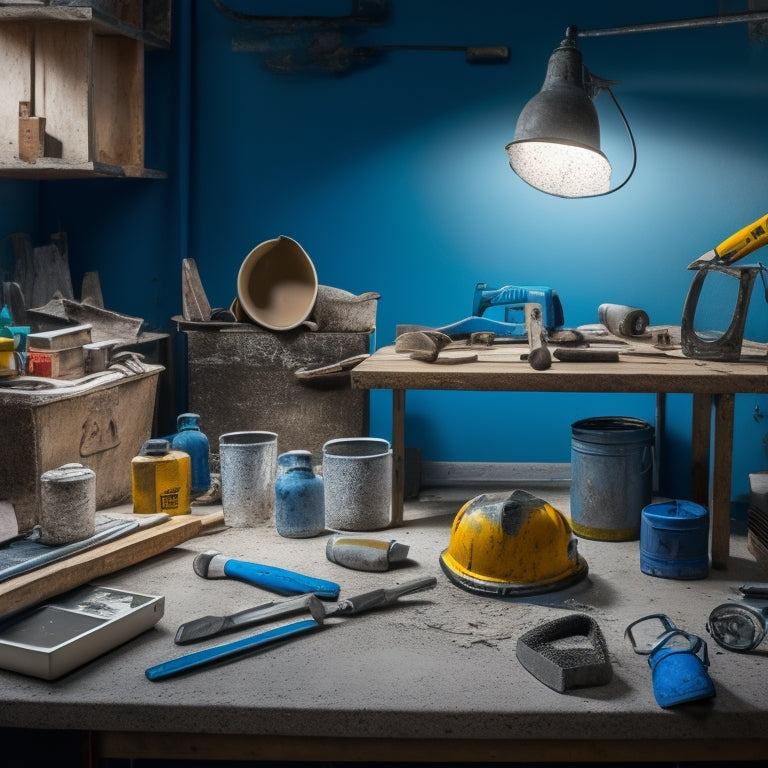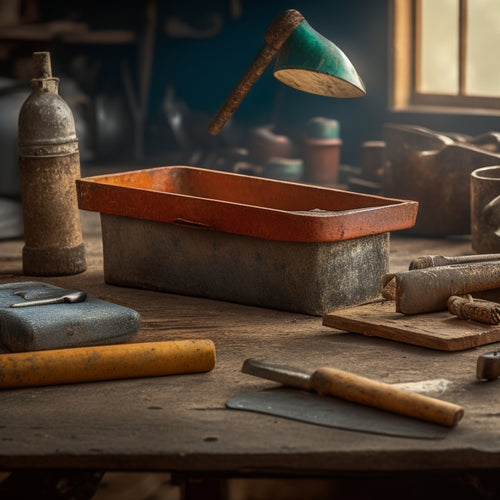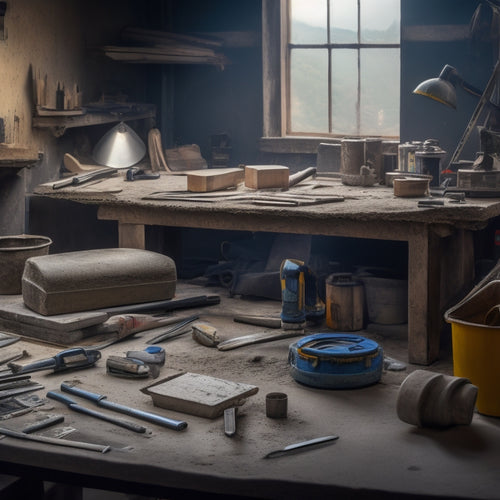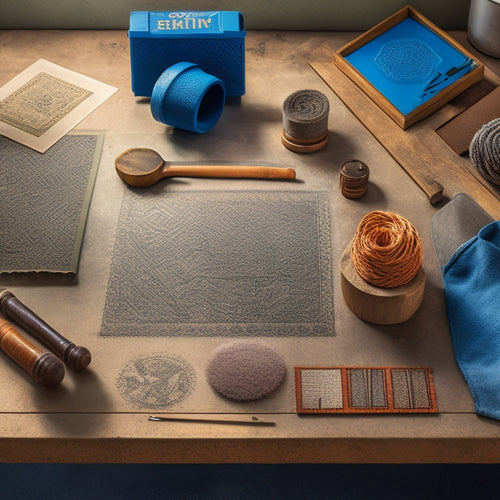
Tools You Need for DIY Concrete Projects
Share
When you take on a DIY concrete project, you'll need essential safety gear like gloves, safety glasses, and a dust mask to protect yourself from harm. Next, assemble your mixing and measuring tools, including a sturdy mixing bucket, high-quality measuring tape, and mixing stick or trowel. Formwork and molding equipment, concrete finishing and smoothing tools, cutting and drilling essentials, and cleaning and maintenance tools will also be necessary. With these must-haves in your toolkit, you'll be well-prepared to tackle your project - and discover the nuances of each tool that can make all the difference in achieving a successful, professional-grade result.
Key Takeaways
• Essential safety gear like gloves, safety glasses, and dust masks protect you from concrete mixing and construction hazards.
• Mixing and measuring tools, including a sturdy bucket and accurate measuring tape, ensure a consistent and durable concrete mix.
• Formwork and molding equipment, such as wooden or metal forms, are necessary for shaping and holding concrete in place.
• Concrete finishing and smoothing tools, like trowels and floats, help achieve a desired surface texture and quality.
• Specialized cutting and drilling tools, including diamond blade saws and tungsten carbide drill bits, make precise cuts and holes in concrete.
Essential Safety Gear Needed
You'll need to wear essential safety gear, including gloves, safety glasses, and a dust mask, to protect yourself from the harsh materials and processes involved in working with concrete. These safety procedures are vital to preventing injuries and ensuring a successful project.
Gloves will shield your hands from abrasive concrete and prevent cuts from sharp objects. Safety glasses will protect your eyes from flying debris and dust, while a dust mask will prevent inhalation of hazardous particles.
In addition to these protective equipment, you'll want to wear long-sleeved shirts, pants, and closed-toe shoes to cover your skin. Steel-toed boots are also recommended to protect your feet from heavy objects.
Remember to tie back long hair and avoid loose jewelry that could get caught in tools or machinery. By following these safety procedures, you'll be able to focus on your project without worrying about your well-being.
Don't compromise on safety – it's better to be prepared and avoid potential risks. With the right protective equipment, you'll be able to tackle your DIY concrete project with confidence.
Mixing and Measuring Tools
With your safety gear in place, you can now focus on the tools that'll help you mix and measure your concrete accurately, starting with a sturdy mixing bucket and a reliable measuring tape.
A mixing bucket with a non-slip handle and a capacity that matches your project's requirements is important for efficient mixing. Invest in a high-quality measuring tape that can withstand harsh job site conditions and provides precise measurements. This guarantees you achieve the right water-to-cement ratio, a significant factor in concrete's strength and durability.
Next, you'll need a mixing stick or trowel to combine your concrete mixture. Choose a mixing stick with a durable handle and a sturdy blade that can withstand the rigors of mixing. This tool is essential for developing a consistent mix and eliminating air pockets.
To refine your mixing techniques, consider investing in a mixing drill or paddle. These tools improve measuring accuracy by guaranteeing a uniform mix, which is critical for achieving the desired concrete strength and finish.
Formwork and Molding Equipment
Forming and shaping your concrete mixture requires the right formwork and molding equipment to achieve the desired shape and dimensions.
You'll need to choose the right formwork types, such as wooden, metal, or plastic, depending on the complexity of your project. Wooden formwork is ideal for simple projects, while metal formwork is better suited for large-scale or complex projects. Plastic formwork, on the other hand, is lightweight and easy to handle.
When it comes to molding materials, you'll need to select the right ones to achieve the desired finish. For example, you can use plywood or oriented strand board (OSB) for a smooth finish, or use a textured material like rough-sawn lumber for a more rustic look.
You may also need to invest in specialized molding tools, such as edging tools or corner molding tools, to create precise edges and corners. Additionally, consider using release agents, such as oil or wax, to prevent the concrete from sticking to the formwork.
With the right formwork and molding equipment, you'll be able to achieve professional-looking results and bring your DIY concrete project to life.
Concrete Finishing and Smoothing
As you move on to the finishing stage, you're faced with a vital decision: choosing the right tools to achieve a smooth, even finish.
You'll need to select from a range of options, including trowels, floats, and edgers, each designed for specific tasks and surface types.
Finishing Tool Options
You'll need to select the right finishing tools to achieve a smooth, even surface, as they play a critical role in concrete finishing and smoothing. The type of trowel you choose will depend on the specific finishing method you're using.
For example, if you're using a float-and-finish method, you'll need a bull float or a fresno trowel to remove excess water and achieve a smooth surface. On the other hand, if you're using a hand-trowel finish, you'll need a variety of handheld trowels, such as a pointing trowel or a notched trowel, to achieve a more textured or patterned finish.
When it comes to finishing methods, you'll need to decide whether to use a power trowel or a manual trowel. Power trowels are ideal for large, flat areas, while manual trowels are better suited for smaller, more intricate areas.
Additionally, you may need to use specialized tools, such as an edger or a jointer, to finish specific areas, like edges or joints. By selecting the right finishing tools and methods, you'll be able to achieve a professional-looking finish that meets your project's requirements.
Smoothing Techniques
With your finishing tools in hand, it's time to master the essential smoothing techniques that will transform your freshly poured concrete into a sleek, even surface.
As you begin, remember that surface preparation is key. Verify your concrete has reached the ideal floating stage, where it's still workable but has started to set.
Now, it's time to apply your smoothing techniques. Start with a bull float or darby to remove any excess material and achieve a uniform surface.
Next, use a hand float or trowel to further refine the surface, feathering out any edges or imperfections.
For an ultra-smooth finish, switch to a steel trowel, working in small, overlapping circles to remove any remaining blemishes.
As you work, maintain a consistent pressure and pace to avoid creating unwanted patterns or marks.
Cutting and Drilling Essentials
Two essential tasks in working with concrete are cutting and drilling, which require the right tools to get the job done efficiently and safely. As you begin your DIY concrete project, it's vital to have the correct saw types and drill bits to make precise cuts and holes.
When it comes to cutting, you'll need a saw that can handle the density of concrete. You'll want to reflect on the following:
-
A diamond blade saw for making straight cuts in thick concrete slabs
-
A concrete circular saw for making curved cuts and demo work
-
A masonry saw for precise cuts in brick, block, and stone
Drilling into concrete requires the right drill bits to avoid damaging the material or the tool. Look for drill bits specifically designed for concrete and masonry, with tungsten carbide tips that can withstand the hardness of concrete.
With the right cutting and drilling tools, you'll be able to complete your DIY concrete project with confidence and precision.
Cleaning and Maintenance Tools
After cutting and drilling, cleaning and maintaining your concrete tools is essential to extending their lifespan and guaranteeing peak performance on your DIY project.
You'll need a set of cleaning and maintenance tools to keep your equipment in top condition. Invest in a stiff-bristle brush, wire brush, and a putty knife to remove dried concrete and debris from your tools. A vacuum or air compressor will also come in handy for blowing out dust and debris from crevices.
When it comes to cleaning techniques, start by wiping down your tools with a damp cloth to remove any loose concrete. For tougher residue, use a wire brush to scrub away stubborn bits. Then, apply a rust-inhibiting coating to protect your tools from corrosion.
For maintenance tips, make it a habit to clean your tools after each use, and store them in a dry, protected area. Regularly inspect your tools for signs of wear and tear, and replace them as needed.
Frequently Asked Questions
Can I Use Regular Gloves Instead of Concrete-Handling Gloves?
When working with concrete, you're tempted to reach for regular gloves, but don't. They won't provide the necessary safety precautions.
Concrete-handling gloves are specifically designed with durable materials that protect your hands from abrasion, punctures, and chemical exposure. Regular gloves, made from thinner materials, won't withstand the harsh conditions and can lead to injuries.
Invest in concrete-handling gloves to guarantee your hands remain safe and protected throughout the project.
How Long Does It Take for Concrete to Fully Cure?
As you wait patiently, wondering when your concrete masterpiece will be ready, the curing process unfolds. It's a slow dance, but one that's essential for achieving ideal concrete strength.
You'll need to allow 24 to 48 hours for the initial set, but full curing can take up to 28 days. During this time, the concrete will continue to harden, reaching its maximum strength.
Be patient, as the wait will be worth it - your concrete will be rock-solid and ready for its debut.
Can I Use a Regular Drill for Drilling Into Concrete?
You're wondering if you can use a regular drill for drilling into concrete? The short answer is no.
Concrete requires specialized drill types, such as hammer drills or rotary hammers, designed to handle the dense material. Regular drills can't generate enough torque, leading to burnt-out motors or broken drill bits.
Instead, invest in drill bits specifically designed for concrete, like carbide-tipped or diamond-coated bits, to guarantee efficient and safe drilling.
Is It Necessary to Seal Concrete After It's Finished?
You're pouring your heart into that concrete project, and it's finally taking shape - like a masterpiece emerging from a blank canvas.
Now, you're wondering if sealing is necessary. The answer is yes.
Sealing concrete offers numerous benefits, including protection from stains, cracks, and weathering.
You'll need to choose from various sealing techniques, such as topical sealers, penetrating sealers, or integral sealers.
Can I Pour Concrete in Extremely Cold or Hot Weather?
When you're planning to pour concrete, you need to evaluate the weather conditions.
In cold weather, you'll want to take precautions to prevent freezing and slow curing, such as using accelerators or insulating blankets.
In hot weather, you'll need strategies to combat rapid drying, like misting the surface or using evaporation retarders.
You'll achieve ideal results by adjusting your mix design and curing methods to suit the temperature.
Conclusion
You've got the tools, now it's time to bring your DIY concrete project to life!
As you commence this creative journey, remember that preparation is key to achieving professional-looking results.
With your arsenal of essential safety gear, mixing and measuring tools, formwork and molding equipment, concrete finishing and smoothing tools, cutting and drilling essentials, and cleaning and maintenance tools, the only thing holding you back is your imagination.
So, what're you waiting for? Get mixing, and let the concrete magic begin!
Related Posts
-

Smart Guide to Buying Used Concrete Hand Tools
You're about to buy used concrete hand tools, and you need to get it right. Dedicate time to identify the tools you n...
-

3 Best Hand Tools for DIY Concrete Construction
When tackling a DIY concrete construction project, you'll need three essential hand tools to achieve a professional-l...
-

5 Best Tools for Stamping Concrete Walls
When it comes to stamping concrete walls, you'll need a range of specialized tools to achieve the desired texture and...


